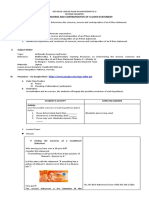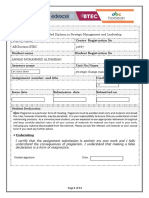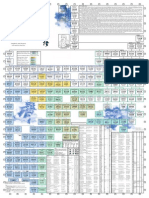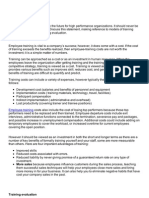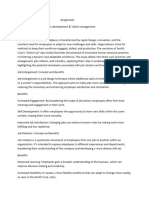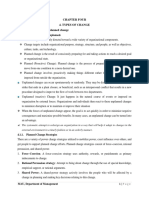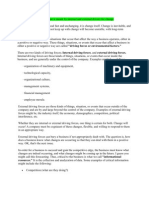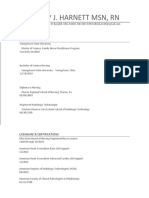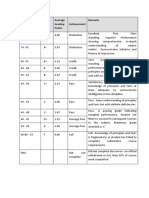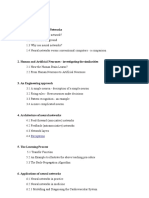Change Management
Change Management
Uploaded by
jaamac cismaanCopyright:
Available Formats
Change Management
Change Management
Uploaded by
jaamac cismaanCopyright
Available Formats
Share this document
Did you find this document useful?
Is this content inappropriate?
Copyright:
Available Formats
Change Management
Change Management
Uploaded by
jaamac cismaanCopyright:
Available Formats
Chapter 1
The dimension of change
Before getting into the details of managing change, it’s useful to overview the
types of change programs used by organizations and the different approaches to
change that can be taken. This broad view will help you later as we get into the
nitty-gritty of managing change.
Types of Change
Organizations typically respond to the challenges of new technologies, new
competitors, new markets, and demands for greater performance with various
programs, each designed to overcome obstacles and enhance business
performance. Generally, these programs fall into one of the following categories:
• Structural change.–These programs treat the organization as a set of functional
parts—the “machine” model. During structural change, top management, aided
by consultants, attempts to reconfigure these parts to achieve greater overall
performance.
Mergers, acquisitions, consolidations, and divestiture of operating units are all
examples of attempts at structural change.
• Cost cutting.–Programs such as these focus on the elimination of nonessential
activities or on other methods for squeezing costs out of operations.Activities
and operations that get little scrutiny during profitable years draw the attention
of cost cutters when times are tough.
• Process change.–These programs focus on altering how things get done.You’ve
probably been involved with one or more of these. Examples include
reengineering a loan approval process, the company’s approach to handling
customer warranty claims, or even how decisions are made. Process change
typically aims to make processes faster, more effective, more reliable, and/or
less costly.
• Cultural change.–These programs focus on the “human” side of the organization,
such as a company’s general approach to doing business or the relationship
between its management and employees. A shift from command-and-control
management to participative management is an example of cultural change, as
is any effort to reorient a company from an inwardly focused “product push”
mentality to an outward-looking customer focus.
Two Different Approaches to Change
While there are many types of change programs, two very different goals
typically drive a change initiative: near-term economic improvement or an
improvement in organizational capabilities. Harvard Business School professors
Michael Beer and Nitin Nohria coined the terms “Theory E” and “Theory O” to
describe these two basic goals.
Theory E: An Economic Approach
The explicit goal of Theory E change is to dramatically and rapidly increase
shareholder value, as measured by improved cash flow and share price. Popular
notions of employee participation and the “learning organization” take a back
seat to this overarching goal. Financial crisis is usually the trigger for this
approach to change. Driven to increase shareholder value,Theory E proponents
rely heavily on mechanisms likely to increase short-term cash flow and share
price: performance bonuses, headcount reductions, asset sales, and strategic
reordering of business units. According to Theory E, all implicit contracts
between the company and its employees, such as lifetime employment, are
suspended during the change effort. Individuals and units whose activities fail to
demonstrate tangible value creation—for example, corporate planning or R&D—
are particularly vulnerable.
Theory O: An Organizational Capabilities Approach
The goal of Theory O change is to develop an organizational culture that
supports learning and a high performance employee base. Companies that
follow this approach attempt to invigorate their cultures and capabilities through
individual and organizational learning. And that requires high levels of employee
participation.
Which Is Best—Or Most Appropriate?
If your organization is considering a major change program, you are probably
wondering which is best. Unfortunately, the record shows that neither approach
is a guarantee of success.Theory E, aiming for rapid improvements in
profitability, often succeeds in the short run, but does so at the expense of
future vitality. By decimating employee ranks, it leaves survivors demoralized
and disloyal.Any commitmentthey had to the company and its goals evaporates.
Ironically, the people the organization hopes to retain—the brightest and most
marketable employees—are among the first to snap up severance packages and
look for greener pastures.
Nor do Theory E’s draconian measures always produce the desired results. A
survey conducted after the last wave of corporate downsizings (late 1980s
through early 1990s) found that only 45 percent of downsizers reported higher
operating profits. Theory O is not an ideal solution either. Reorienting corporate
culture around employee commitment and learning is a noble endeavor, but it is
a multiyear proposition. A successful program may produce a smarter,more
adaptive employee base in four to five years, but companies that really need
change cannot wait that long for results. Managers and employees, not to
mention analysts and shareholders, simply aren’t that patient.
TABLE 1 - 1
Key Factors in Theory E and Theory O Change
Cbdi baqaf 6000 - 4929323- axmed-4005332
Gaadhi Buuhoodle lagu sameeyay – 259 – 4971197 Cawil
Waraabe 859.85- shiidaal garaadka, aadan shuuriye, cuqaasha
Name: _______________________________________ ID.No.____________
Part 1. Write true if the statement is correct and false if the
statement is incorrect (1 pt each). Write complete TRUE/FALSE.
1. Theory E of change is to develop an organizational culture that
supports learning and a high performance employee base ( F
)
2. Top-driven change doesn’t create people problems ( F )
3. Describing desirable future for labor increases labor acceptance for
change ( T )
4. The goal of theory E change is to maximize shareholder value ( T
)
5. Theory E change aims at rapid improvements in profitability ( T
)
Part 2. Choose the correct answer from the given alternative (1.5pts
each)
1. In making change organizations should focus one
A. Results
B. Activities
C. Shared goals
D. None of the above
2. Focus of theory E lies on
A. Manage change from the top
B. Emphasize structure and system
C. Build up corporate culture
D. All of the above
3. We can expect a greater probability of success if the change
contemplated has the following features
A. Clear advantages over the status quo;
B. Compatibility with peoples’ deeply-held values,
C. Requirements that are understandable
D. All of the above
4. Problem identification without its _______ identification is nothing
A. Common sense
B. Solution
C. Idea generation
D. None of the
5. In communicating the vision, be very specific about how the change
will
A. Improve the business
B. How those improvements will benefit employees
C. Improve customer satisfaction
D. All of the above
6. These programs treat the organization as a set of functional parts—the
“machine” model
A. Cost cutting
B. Structural change
C. Process change
D. Cultural change
Part 3. Short answer (2pts each)
1. Differentiate between theory O and theory E of change?
2. List at least steps of change?
3. List and elaborate two types change?
You might also like
- Converse, Inverse and Contrapositive of A Given StatementDocument3 pagesConverse, Inverse and Contrapositive of A Given StatementCherrina Lazaro Gabriel100% (5)
- Strategic Change Management AssignmentDocument11 pagesStrategic Change Management Assignmentمحمد الشيبةNo ratings yet
- Ferguson - Lineage Chart of The Zen Ancestors in ChinaDocument1 pageFerguson - Lineage Chart of The Zen Ancestors in Chinag.vadala5761No ratings yet
- Change ManagementDocument9 pagesChange ManagementManish SinghNo ratings yet
- Change ManagementDocument17 pagesChange ManagementMeenakshi Bisht Rawat100% (2)
- Assessment Task 1: Answer To The Question No:1Document5 pagesAssessment Task 1: Answer To The Question No:1Kamrul Islam SakibNo ratings yet
- UGC NET JRF - Social Work Syllabus and Resource LinksDocument11 pagesUGC NET JRF - Social Work Syllabus and Resource LinksS.Rengasamy100% (20)
- Study: Teaching With The Instructional Cha-ChasDocument48 pagesStudy: Teaching With The Instructional Cha-ChasMummy Masayu100% (1)
- OCD Unit 2Document16 pagesOCD Unit 2vedant.kanu03No ratings yet
- Chapter 11 - Organizational Change and DevelopmentDocument7 pagesChapter 11 - Organizational Change and DevelopmentThisisfor TiktokNo ratings yet
- Change Management 1Document50 pagesChange Management 1rocknroll_mahive1789No ratings yet
- 5 Driving Radical Change Mckinsey PDFDocument13 pages5 Driving Radical Change Mckinsey PDFAlberto AdánNo ratings yet
- ShimulDocument9 pagesShimulFida HasanNo ratings yet
- 603 - Organisational Change and DevelopmentDocument11 pages603 - Organisational Change and DevelopmentlocalsingerytNo ratings yet
- Managing For Quality Essay QuestionsDocument28 pagesManaging For Quality Essay QuestionsKimNo ratings yet
- HR Professionals Guide To Business TransformationDocument15 pagesHR Professionals Guide To Business TransformationMaven Training100% (1)
- BCG The New CEO's Guide To Transformation May 2015 Tcm80 188487Document21 pagesBCG The New CEO's Guide To Transformation May 2015 Tcm80 188487nashvegas1100% (2)
- Orginizational Change Management PDFDocument9 pagesOrginizational Change Management PDFLillian KahiuNo ratings yet
- Change Management-E1Document14 pagesChange Management-E1priya h.pNo ratings yet
- ODDocument18 pagesODMeenakshi GodaraNo ratings yet
- Answer of Some HRM ActivitiesDocument6 pagesAnswer of Some HRM ActivitiesAl AminNo ratings yet
- MS 25Document6 pagesMS 25Rajni KumariNo ratings yet
- MU0018 - Sem 4 - Fall 2011Document3 pagesMU0018 - Sem 4 - Fall 2011Ashraf HussainNo ratings yet
- Downsizing Refers To Interventions Aimed at Reducing: Application StagesDocument3 pagesDownsizing Refers To Interventions Aimed at Reducing: Application StagesSarosh KhanNo ratings yet
- Untitled DocumentDocument3 pagesUntitled DocumentMusa GorodNo ratings yet
- Skill Test 3Document66 pagesSkill Test 3rzeeshan053No ratings yet
- Agnes Acam Einyu 2015 Making Strategies Work NotesDocument26 pagesAgnes Acam Einyu 2015 Making Strategies Work NotesOswin ChogaNo ratings yet
- Devry HRM587 Final Exam Latest - 2016Document10 pagesDevry HRM587 Final Exam Latest - 2016candypopNo ratings yet
- CH 16Document21 pagesCH 16Teddy MetaNo ratings yet
- Employee DevelopmentDocument9 pagesEmployee Developmentdimplepahuja27No ratings yet
- MGMT725 PDFDocument121 pagesMGMT725 PDFRABIA100% (1)
- Module 3 OD Diagnostic StudyDocument9 pagesModule 3 OD Diagnostic Studymarian oclaritNo ratings yet
- ChangeManagement FinalAssignmentDocument16 pagesChangeManagement FinalAssignmentArulNo ratings yet
- Content of ResearchDocument10 pagesContent of ResearchYousef QuriedNo ratings yet
- Mid-Term Test Full Sets FormatDocument7 pagesMid-Term Test Full Sets FormatKieu NhungNo ratings yet
- TỔNG HỢP CUỐIDocument258 pagesTỔNG HỢP CUỐILê Quốc KhánhNo ratings yet
- Individual Assignment On Change MGT BirhanDocument6 pagesIndividual Assignment On Change MGT BirhanBro38867No ratings yet
- BAIN Busting Three Common Myths of Change ManagementDocument12 pagesBAIN Busting Three Common Myths of Change ManagementDonna DownsNo ratings yet
- Q A On Change ManagementDocument9 pagesQ A On Change ManagementAnonymous v5QjDW2eHxNo ratings yet
- Leading Change: Why Transformation Efforts Fail??: Mind-Sets Create Resistance To ChangeDocument6 pagesLeading Change: Why Transformation Efforts Fail??: Mind-Sets Create Resistance To ChangeBhawana SinhaNo ratings yet
- Chapter Four 4. Types of Change 4.1. Planned Versus Unplanned ChangeDocument8 pagesChapter Four 4. Types of Change 4.1. Planned Versus Unplanned ChangeMelkamu TemesgenNo ratings yet
- Managing Change in Theory and Practice - Case Study - AnswersDocument18 pagesManaging Change in Theory and Practice - Case Study - Answersjuly_27No ratings yet
- Change ManagementDocument22 pagesChange ManagementSimit KhajanchiNo ratings yet
- SM-khoa-truoc-da-sort - Strategic ManagementDocument25 pagesSM-khoa-truoc-da-sort - Strategic ManagementYen HoangNo ratings yet
- How Do I Implement Complex Change at Scale PDFDocument16 pagesHow Do I Implement Complex Change at Scale PDFRuddy Morales MejiaNo ratings yet
- Continuous ImprovementDocument12 pagesContinuous ImprovementCħáwķołáty Náwtîlîçiøux ǷwIncḗNo ratings yet
- HRPRS ProjectDocument4 pagesHRPRS ProjectAditi Mahesh ShindeNo ratings yet
- DeVry HRM 587 Final Exam 100% Correct AnswerDocument9 pagesDeVry HRM 587 Final Exam 100% Correct AnswerDeVryHelpNo ratings yet
- Question 1 - (A) What Is Change Management? (B) Explain The Importance of Change Management. AnswerDocument8 pagesQuestion 1 - (A) What Is Change Management? (B) Explain The Importance of Change Management. Answernitin.1n11599No ratings yet
- Chapter 10 Organizing and StructureDocument21 pagesChapter 10 Organizing and StructurePaupau100% (1)
- Examining The Definition of Change ManagementDocument8 pagesExamining The Definition of Change Managementabhijeet801No ratings yet
- Understanding The Meaning of Change ManagementDocument2 pagesUnderstanding The Meaning of Change ManagementNangoli SudiNo ratings yet
- Change ManagementDocument2 pagesChange ManagementNangoli SudiNo ratings yet
- 10.synergy & Change ManagementDocument5 pages10.synergy & Change ManagementTYBMS F 3023 JAIN RIYA PUKHRAJNo ratings yet
- Accenture Outlook Change Capable OrganizationDocument11 pagesAccenture Outlook Change Capable OrganizationjibranqqNo ratings yet
- Answer 1 Case ToyotaDocument7 pagesAnswer 1 Case ToyotaHendrickson Cruz SaludNo ratings yet
- Strategic Change Process: SyllabusDocument32 pagesStrategic Change Process: Syllabussamreen workNo ratings yet
- Change Management BookDocument343 pagesChange Management BookDuy HoNo ratings yet
- ChapterDocument31 pagesChapter1202 - Cantel, RonalynNo ratings yet
- Final OddDocument10 pagesFinal OddrahulfaliyaNo ratings yet
- Cost Reduction Strategies for the Manufacturing Sector With Application of Microsoft ExcelFrom EverandCost Reduction Strategies for the Manufacturing Sector With Application of Microsoft ExcelNo ratings yet
- The Leadership Shift: How to Lead Successful Transformations in the New NormalFrom EverandThe Leadership Shift: How to Lead Successful Transformations in the New NormalNo ratings yet
- 200+ US University ListDocument11 pages200+ US University ListJosown BrounNo ratings yet
- Faculty of Management Studies: Guide List Summer Project June 2022 S.NO. R.No Reg No Student NameDocument32 pagesFaculty of Management Studies: Guide List Summer Project June 2022 S.NO. R.No Reg No Student NameVijay MNo ratings yet
- Test Unit 1Document4 pagesTest Unit 1Αιμιλία ΙατρίδηNo ratings yet
- Kel CVDocument3 pagesKel CVapi-567380846No ratings yet
- PsychologyDocument3 pagesPsychologyNishtha PandeyNo ratings yet
- Module 6 Teaching Multigrade ClassesDocument2 pagesModule 6 Teaching Multigrade ClassesWinter BacalsoNo ratings yet
- EDUC 5910 Informed Consent FormDocument4 pagesEDUC 5910 Informed Consent FormBob BaldricNo ratings yet
- Patricia BennerDocument7 pagesPatricia BennerGemgem AcostaNo ratings yet
- MIL - DLL 4TH Quarter - Week 4Document9 pagesMIL - DLL 4TH Quarter - Week 4dannelponanNo ratings yet
- Aubrey Dela Cruz - Personal PhilosophyDocument2 pagesAubrey Dela Cruz - Personal Philosophyapi-669445662No ratings yet
- Demonstration in Law of IntegersDocument55 pagesDemonstration in Law of IntegersMary Ann EspendeNo ratings yet
- Rancangan Pengajaran Harian (RPH) Prasekolah SJK (C) ManchisDocument10 pagesRancangan Pengajaran Harian (RPH) Prasekolah SJK (C) ManchisYih ChiannNo ratings yet
- Gomti Deshmukh: Career Ob JectiveDocument1 pageGomti Deshmukh: Career Ob JectiveSHOAIB MEMONNo ratings yet
- APQP - Core Tools of QualityDocument108 pagesAPQP - Core Tools of Qualitykiran kumar psNo ratings yet
- ICCE2022-Implementing STEM Integrated Inquiry-Based CooperativeDocument6 pagesICCE2022-Implementing STEM Integrated Inquiry-Based CooperativeRakchanoke YaileearngNo ratings yet
- One Word SubstituteDocument12 pagesOne Word SubstituteSolaisaran KvNo ratings yet
- The Research ProblemDocument7 pagesThe Research ProblemFrancine Marie FloridaNo ratings yet
- Raz lf33 Mothersday PDFDocument12 pagesRaz lf33 Mothersday PDFChrista Claire SevillaNo ratings yet
- Nurse Leader Nurs 440Document8 pagesNurse Leader Nurs 440api-273238350No ratings yet
- 5 SC My Incubation Plan - Feb 6Document20 pages5 SC My Incubation Plan - Feb 6Lobzang DorjiNo ratings yet
- Marks Grade Average Grading Points Achievement RemarksDocument1 pageMarks Grade Average Grading Points Achievement RemarksAlif PutauNo ratings yet
- Evaluating Sources: Group 4 PresentationDocument12 pagesEvaluating Sources: Group 4 PresentationBrianna StoneNo ratings yet
- Ground Floor Plan Second Floor Plan Roof Deck Plan: A B C A B CDocument1 pageGround Floor Plan Second Floor Plan Roof Deck Plan: A B C A B CFred GervacioNo ratings yet
- CSTP 3 - Understanding and Organizing Subject Matter For Student LearningDocument2 pagesCSTP 3 - Understanding and Organizing Subject Matter For Student Learningapi-529100008100% (1)
- Contents:: 1. Introduction To Neural NetworksDocument27 pagesContents:: 1. Introduction To Neural NetworksKarthik VanamNo ratings yet
- Hasil Olimpiade Geografi Tingkat Sma SeDocument6 pagesHasil Olimpiade Geografi Tingkat Sma SesriyandidjoeweriNo ratings yet
